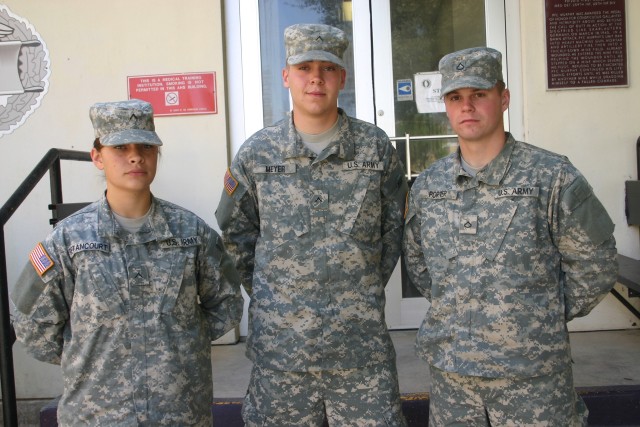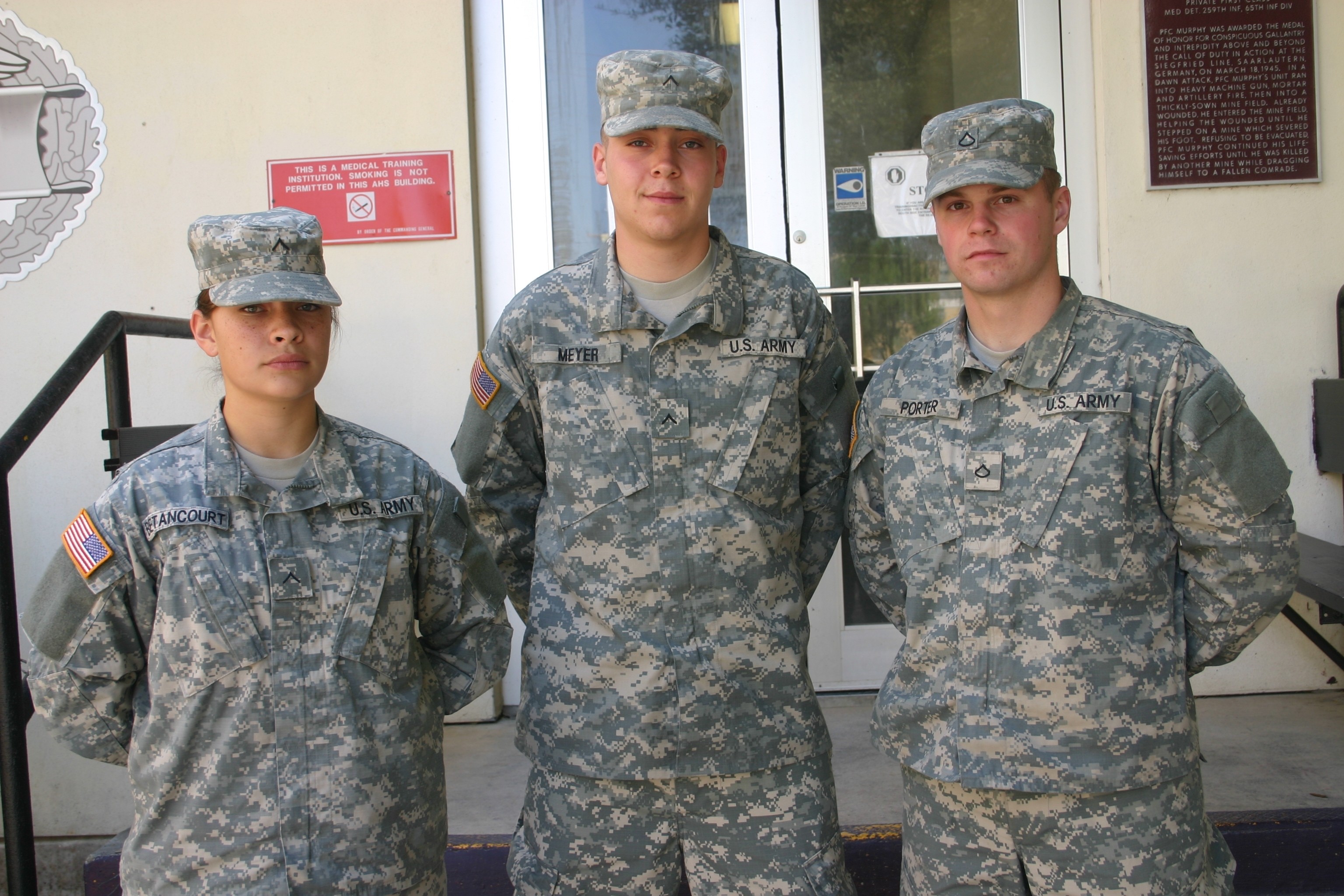FORT SAM HOUSTON, Texas (Army News Service, March 27, 2008) -- Just a few days after graduation from combat medic training, three Soldiers put their newly acquired medical skills to the test.
The test did not take place during a field training exercise or on a battlefield in Iraq, but on a stretch of Texas highway about 30 miles southeast of San Antonio.
The Soldiers, Pfc. Richard Porter, Pvt. Claudia Betancourt and Pvt. Christopher Meyer, of C Company, 232nd Medical Battalion, were returning from a weekend pass to MeyerAca,!a,,cs home in Corpus Christi. MeyerAca,!a,,cs mother, Pamila, offered to drive the Soldiers back to Fort Sam Houston.
Meyers recalls talking in the car with his friends about their recent training and whether it would prove effective, a conversation that would later strike him as an omen.
They were about a half-hour from post when Pamila saw an overturned SUV on the side of the road.
Aca,!A"We all looked over and saw the accident, but when we looked again, we saw the bodies,Aca,!A? Meyer said.
They pulled over immediately and the Soldiers quickly surveyed the situation. Two people were standing and three others were lying on the ground. They proceeded over to a male, one of two severely injured victims.
Aca,!A"There was a guy lying on the ground bleeding profusely from the nose and mouth; heAca,!a,,cd been ejected from the car,Aca,!A? Meyer said.
Meyer and Porter stopped to help him, while Betancourt moved on to render aid to another victim.
Aca,!A"There were a group of civilians around the man and they were trying to move him because he was face down,Aca,!A? Meyer said. Aca,!A"We stopped them. If they had moved him, he probably would be paralyzed now.Aca,!A?
Porter stayed with the male to take his vitals and medical background while Meyer moved on to assist Betancourt, who was treating a female with an open skull fracture.
Aca,!A"She was having a hard time breathing so we rolled her on her side,Aca,!A? Betancourt said. As a result, the victimAca,!a,,cs respiration improved from 4 breaths per minute to 22.
The Soldiers provided medical assistance until the police and emergency medical technicians arrived.
Aca,!A"We let them know we were Army medics and wanted to help,Aca,!A? Meyer said.
The Soldiers were concerned that they would be turned away since they were dressed in sweats, not uniforms, but Aca,!A"at no time did any of the law enforcement or emergency personnel treat these Soldiers as intruders,Aca,!A? MeyerAca,!a,,cs mother Pamila said. Aca,!A"In fact, it was just the opposite. The people on the scene treated these Soldiers as the professionals they were trained to be and allowed them to do their jobs. They did not disappoint.Aca,!A?
The Soldiers started intravenous fluids, placed oxygen masks, changed out oxygen tanks, secured the injured to backboards and dressed wounds.
In a letter to the commander, MeyerAca,!a,,cs mother described the scene. Aca,!A"They were amazing. As the wounded were stabilized and prepared for transport, I watched as these Soldiers held the hands of victims, offered a shoulder for tears and told some corny jokes to elicit a smile and even laughter.Aca,!A?
The two most seriously injured were taken to San Antonio by helicopter and the other three were transported by ambulance to local hospitals.
As the Soldiers prepared to head back to San Antonio, they took with them a new perspective on their training.
Aca,!A"IAca,!a,,cd be lying if I said I wasnAca,!a,,ct nervous when I first ran up to the victims,Aca,!A? Meyer said. Aca,!A"But when I got to the first patient, my training kicked in and it was mechanical.Aca,!A?
The Soldiers attribute their calm reaction to stressful, realistic training.
Aca,!A"We had been exposed to gun shots, loud noises and yelling in training,Aca,!A? Meyer said. Aca,!A"So we were able to block out everything and just focus on the patients.Aca,!A?
The incident also banished the SoldiersAca,!a,,c earlier doubts about their training.
Aca,!A"During training we practiced on dummies or our battle buddies, so we had wondered if we could perform with live patients,Aca,!A? Meyer said. Aca,!A"I definitely feel a lot more confident now.Aca,!A?
Aca,!A"In one hour of medical assistance, we applied everything we learned in 16 weeks of training. The training prepared us for this and for a lot worse,Aca,!A? said Porter.
Their company commander, Capt. Justin Avery, said the Army strives to provide Soldiers with the knowledge to save lives. Aca,!A"As long as they remember the basics, there is nothing they canAca,!a,,ct accomplish when it comes to saving a life.Aca,!A?
The Soldiers later learned all survived the accident with the exception of the female with the head trauma.
Aca,!A"I think they performed magnificently. They werenAca,!a,,ct on a normal Army mission and they werenAca,!a,,ct required to render assistance,Aca,!A? Avery said. Aca,!A"I truly believe it was their efforts that prolonged the lives of the civilians involved in the vehicle accident.Aca,!A?


Social Sharing